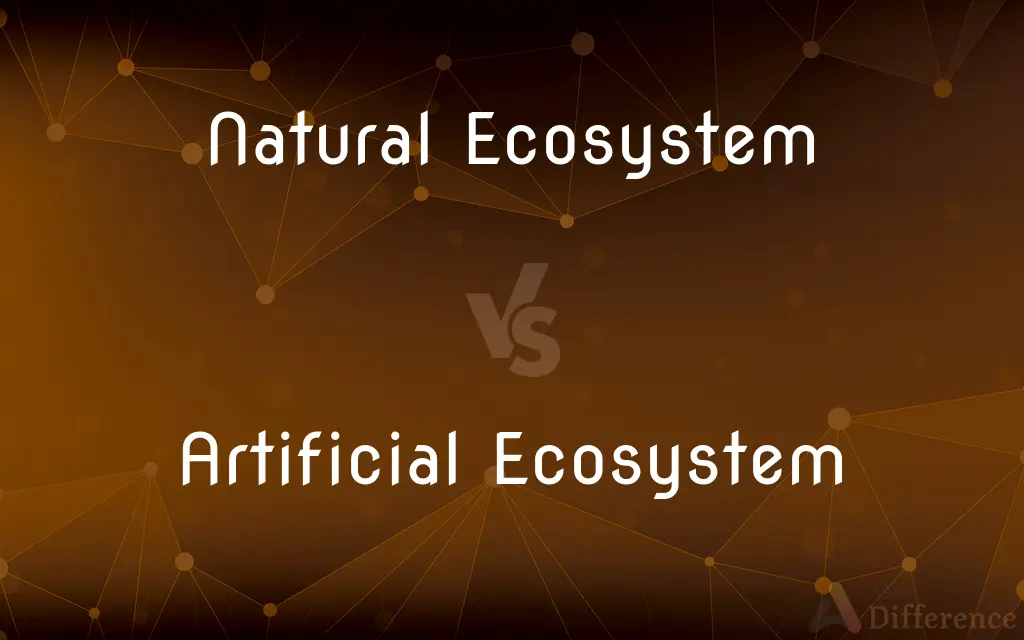Natural Ecosystem vs. Artificial Ecosystem — What's the Difference?
Edited by Tayyaba Rehman — By Fiza Rafique — Published on January 10, 2024
Natural Ecosystem is a Self-sustaining, biotic-abiotic interactions. Artificial Ecosystem is a human-designed, maintained ecosystems.

Difference Between Natural Ecosystem and Artificial Ecosystem
Table of Contents
ADVERTISEMENT
Key Differences
A natural ecosystem is a community of living organisms in conjunction with the nonliving components of their environment, interacting as a system. These biotic and abiotic components are linked together through nutrient cycles and energy flows. Artificial ecosystems, however, are man-made setups like agricultural fields and aquariums, where conditions are artificially maintained to support life.
Natural ecosystems evolve without human intervention. The balance of a natural ecosystem is maintained through predation, resource availability, and other natural processes. In contrast, artificial ecosystems require significant human management to maintain such balances, often relying on external resources like fertilizer in agriculture or filters in aquariums.
The diversity of species in a natural ecosystem is determined by the resilience and adaptability of the ecosystem to changing conditions over time. In an artificial ecosystem, species diversity is often limited and selected by human choice, primarily for specific purposes like crop production or ornamental display.
Natural ecosystems are characterized by complex food webs, energy flow, and nutrient cycles that have developed over time. Artificial ecosystems tend to have simpler food webs, often disrupted by human intervention, and may rely on artificial energy and nutrient inputs to sustain the system.
Lastly, natural ecosystems provide a wide range of ecosystem services including climate regulation, water purification, and habitat provision. Artificial ecosystems, while they can provide services like food production and recreational spaces, generally offer fewer ecosystem services and can require more inputs to mitigate environmental impacts.
ADVERTISEMENT
Comparison Chart
Origin
Developed through natural processes
Created or heavily managed by humans
Maintenance
Self-sustaining with natural processes
Requires human intervention to sustain
Biodiversity
High biodiversity due to natural selection
Often limited biodiversity chosen by humans
Resource Cycling
Nutrient cycles are closed and self-regulated
Often require external inputs like fertilizers
Ecosystem Services
Provides a wide range of services naturally
Usually provides specific services
Compare with Definitions
Natural Ecosystem
Self-regulating environments with native species.
The Serengeti is an example of a natural ecosystem with a dynamic balance.
Artificial Ecosystem
Man-made systems often designed for specific purposes.
Fish tanks are artificial ecosystems created for the purpose of keeping aquatic pets.
Natural Ecosystem
A biological community interacting with its physical environment.
The Amazon rainforest is a vast natural ecosystem.
Artificial Ecosystem
Controlled habitats with selected species and conditions.
Greenhouses are artificial ecosystems designed for optimal plant growth.
Natural Ecosystem
Ecosystems evolving without human interference.
Coral reefs are diverse natural ecosystems critical to marine life.
Artificial Ecosystem
Environments where humans manage energy and nutrient flows.
Agricultural lands are artificial ecosystems with managed soil fertility.
Natural Ecosystem
A system with interconnected food webs and natural cycles.
Wetlands are natural ecosystems that perform essential water purification.
Artificial Ecosystem
Habitats needing external inputs to maintain ecological balance.
Golf courses are artificial ecosystems that require constant maintenance.
Natural Ecosystem
Habitats that develop their own equilibrium over time.
The natural ecosystem of the Mississippi River delta supports a variety of wildlife.
Artificial Ecosystem
Ecosystems modified or created by human intervention.
Urban parks are artificial ecosystems within city landscapes.
Common Curiosities
Can a natural ecosystem exist without human intervention?
Yes, natural ecosystems can exist and thrive without human intervention.
What are some examples of natural ecosystems?
Examples include forests, oceans, and grasslands.
Does a natural ecosystem have an impact on the environment?
Yes, natural ecosystems play a crucial role in environmental health and balance.
What defines a natural ecosystem?
A natural ecosystem is defined by its self-sustaining processes and natural biodiversity.
What's a common purpose of artificial ecosystems?
They are often created for human benefits, such as agriculture or aesthetics.
Can artificial ecosystems become natural over time?
They can develop more natural characteristics but usually retain some level of human influence.
How do natural and artificial ecosystems differ in energy flow?
Natural ecosystems have self-sustaining energy flows, while artificial ones often require input.
Are artificial ecosystems sustainable?
They can be, but sustainability often requires careful management and can be resource-intensive.
How does a natural ecosystem maintain balance?
Through natural processes like predation, decomposition, and nutrient cycling.
Can artificial ecosystems support biodiversity?
They can, but biodiversity is often limited and controlled compared to natural ecosystems.
Are all human-altered environments considered artificial ecosystems?
Not all; the term usually applies to systems heavily managed or entirely built by humans.
Do artificial ecosystems require maintenance?
Yes, they typically need ongoing human maintenance.
How do artificial ecosystems impact the environment?
They can have varied impacts, from providing green spaces to altering natural habitats.
What is an artificial ecosystem?
An artificial ecosystem is a human-constructed or managed system where organisms live.
Can artificial ecosystems offer ecosystem services?
Yes, but usually fewer than natural ecosystems and often at a higher resource cost.
Share Your Discovery

Previous Comparison
Fb Messenger Sent vs. Fb Messenger Delivered
Next Comparison
Graphene Oxide vs. Reduced Graphene OxideAuthor Spotlight
Written by
Fiza RafiqueFiza Rafique is a skilled content writer at AskDifference.com, where she meticulously refines and enhances written pieces. Drawing from her vast editorial expertise, Fiza ensures clarity, accuracy, and precision in every article. Passionate about language, she continually seeks to elevate the quality of content for readers worldwide.
Edited by
Tayyaba RehmanTayyaba Rehman is a distinguished writer, currently serving as a primary contributor to askdifference.com. As a researcher in semantics and etymology, Tayyaba's passion for the complexity of languages and their distinctions has found a perfect home on the platform. Tayyaba delves into the intricacies of language, distinguishing between commonly confused words and phrases, thereby providing clarity for readers worldwide.
















































